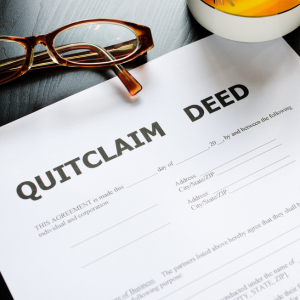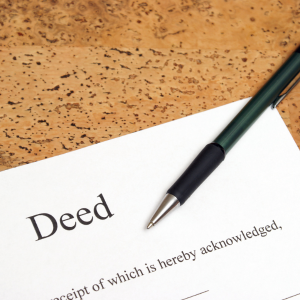
Understanding The Process Of Filing A Quit Claim Deed In California
Understanding the steps of filing a quit claim deed in California is crucial for successfully transferring real estate property ownership despite its complexity. The first step is to get the necessary forms at the county recorder’s office or online.
After you complete and sign the form, it must be notarized and filed with the county recorder’s office. Next, you must pay any transfer-related fees and taxes.
All details on the deed must be carefully reviewed before filing to ensure accuracy and avoid future issues. Seek legal guidance from a real estate attorney to navigate applicable state laws and regulations.
Mastering this process allows you to confidently file a quit claim deed in California and smoothly transfer property ownership.
Important Considerations Before Filing A Quit Claim Deed In California

Before filing a quit claim deed in California for your real estate property, there are several important things to consider. Understanding the purpose and distinctions between quit claim deeds and other property transfers is crucial.
Furthermore, you should carefully review the language and terms of the deed to ensure that they accurately reflect your intentions. Before filing a quit claim deed, research any potential tax or legal consequences.
Before filing, consult with a real estate attorney or professional to ensure proper steps and address potential issues. By considering these factors, you can complete the process of filing a quit claim deed in California for your real estate property.
Exploring The Legal Requirements For Filing A Quit Claim Deed In California
In California, filing a quit claim deed for real estate property requires adhering to legal requirements. The first step is ensuring the deed is properly drafted and executed following state laws.
To complete the transaction, all parties must sign the deed before a public notary and obtain a legal property description. The deed must also be recorded with the county recorder’s office where the property is located.
It should also be noted that any outstanding liens or encumbrances on the property must be resolved before filing the quit claim deed. Failure to comply with these legal requirements can cause complications and, in some cases, invalidate the transfer of ownership.
To successfully file a quit claim deed in California, it’s crucial to research and understand the necessary steps thoroughly.
Common Mistakes To Avoid When Filing A Quit Claim Deed In California

When you file a quit claim deed in California for your home, it’s important not to make common mistakes that could slow down or even ruin the process. One of the most common mistakes people make is not getting everyone to sign the deed.
For the quit claim deed to be valid in California, at least one property owner must sign it. Another mistake you should avoid is making the wrong preparations and not recording the deed with the county recorder’s office.
This could make it hard to change ownership and cause future legal problems. Not giving a correct description of the property on the deed can also lead to confusion and disagreements in the future.
Before filing the quit claim deed, it is also very important to ensure that any mortgages or liens still on the property are taken care of. Do not make these common mistakes when filing a quit claim deed in California. This will help you get your property released quickly and easily.
The Benefits Of Using A Lawyer For Filing A Quit Claim Deed In California
Despite how easy it may seem, hiring a lawyer to help you file a quit claim deed in California is a wise investment. An experienced real estate attorney can be a great asset, even though it’s tempting to save money and do the paperwork yourself.
With their help, you can rest assured that all required paperwork will be meticulously prepared and filed, leaving no room for mistakes. A lawyer can also be useful in resolving any disputes or legal issues that may crop up throughout the property transfer process.
They are well-versed in California real estate laws and can help you rest easy knowing that the quit claim deed is filed accurately and without any issues. Ultimately, it’s in your best interest to hire a lawyer to file the quit claim deed in California. They will ease your burden, save you time, and safeguard your investment in the property.
How To Obtain And Complete The Necessary Forms For Filing A Quit Claim Deed In California

Obtaining and filling out the necessary forms for filing a quit claim deed in California is a critical step toward successfully transferring your real estate property ownership. According to California law, the grantor must fill out a Grant Deed form, which includes information about the property and the parties involved.
In addition, a Preliminary Change of Ownership Report (PCOR) form must be completed, which includes information about the transfer and any tax exemptions. These forms must be carefully reviewed and accurately filled out to avoid delays or complications.
These forms can be obtained from the county recorder’s office or downloaded from the website. Before filing any forms with the county recorder’s office, it is recommended that you consult with a legal professional to ensure that they are properly filled out.
Follow these steps to successfully file a quit claim deed for your California real estate property.
Tips For Drafting An Effective Quit Claim Deed In California
When filing a quit claim deed in California for your real estate property, you must first understand the process and be familiar with the steps involved. To ensure success, follow these key tips when drafting an effective quit claim deed in California.
First and foremost, ensure that all parties involved fully understand and accept the terms of the deed. This includes clearly stating the property to be transferred and any relevant details or conditions.
Furthermore, it is critical to accurately describe the type of ownership being transferred, whether joint tenancy or common property. You should also include a legal description of the property and any encumbrances or liens.
Furthermore, having the deed notarized and properly executed with both parties’ signatures can help prevent future legal issues. These guidelines will allow you to confidently file a quit claim deed for your real estate property in California.
Understanding The Tax Implications Of Filing A Quit Claim Deed In California

When filing a quit claim deed in California for your real estate property, you should know the tax implications. A quit claim deed transfers property ownership from one party to another without providing any guarantees or warranties.
This means that the person receiving the property is liable for any current taxes, such as property taxes or income taxes on rental properties. Furthermore, gift tax implications may arise if the transfer is treated as a gift rather than a sale.
Before filing a quit claim deed, consult a tax professional to understand and plan for any potential tax consequences fully.
Navigating Through Potential Title Issues When Filing A Quit Claim Deed In California
Navigating potential title issues is critical to successfully filing a quit claim deed in California for your real estate property. These can happen for various reasons, including liens, encumbrances, and the property’s legal description errors.
Before beginning the filing process, conduct extensive research and review of the property’s title history. This includes investigating any outstanding debts or legal disputes that may affect the transfer of ownership.
In addition, consulting with a reputable title company or hiring an experienced real estate attorney can assist in identifying and resolving any potential issues before they delay or impede the filing process. By carefully navigating these potential title issues, you can ensure a smooth and successful transfer of ownership via a California quit claim deed.
The Role Of Notarization And Witnesses When Filing A Quit Claim Deed In California

When filing a quit claim deed for your California real estate property, it is critical to understand the role of notarization and witnesses. Notarization entails having a notary public confirm the identity of the person signing the deed and ensuring that they do so voluntarily and without coercion.
This provides an additional layer of security against fraud or errors. Furthermore, California law requires two witnesses to be present when the deed is signed.
These witnesses must also sign the deed, certifying they witnessed the grantor’s signature. This helps to establish the quit claim deed’s validity and authenticity.
You must strictly adhere to all notarization and witness signature guidelines to ensure your quit claim deed is valid in California.
How To Properly Record And File Your Quit Claim Deed With The County Recorder’s Office
Recording and filing the quit claim deed correctly with the county recorder’s office is very important when transferring property ownership in California. For this process, you must take the deed, any needed forms, and the appropriate fees to the recorder’s office in the county where the property is located.
Everything on the deed should be correct and up to date, including the legal description of the property and the names of everyone involved. Moreover, it is important to adhere to every county’s specific rules and instructions when recording and filing quit claim deeds.
Failure to properly complete this step could cause the transfer to be delayed, fined, or even thrown out. Understanding this process will help you file your quit claim deed in California and ensure that your property transfer goes smoothly.
Exploring Alternative Options To File Your Quit Claim Deed In California
![how to fill out quitclaim deed in market_city]](https://image-cdn.carrot.com/uploads/sites/43286/2024/10/how-to-fill-out-quitclaim-deed.png)
Alternatives exist for filing a California quit claim deed for your real estate. Traditional methods like hiring a lawyer or going through the county recorder are time-consuming and expensive.
With technology and online services, filing a California quit claim deed is faster. Online platforms provide step-by-step instructions and templates so people can complete the process without legal help.
E-recording services in some California counties make the process easier for property owners. These alternatives allow people to file their quit claim deed and save time and money.
Addressing Common Questions And Concerns About Filing A Quit Claim Deed In California
If you don’t know the legal terms and requirements, filing a quit claim deed in California might seem difficult. Any worries or questions can be put to rest if you know the steps and requirements.
A common question is whether a quit claim deed is the best way to transfer ownership of your home. While a quit claim deed does not offer as much protection as a warranty deed, it can still be a good way to change ownership in some situations.
A different question that comes up a lot is what forms and documents are needed to file a quit claim deed in California. The Preliminary Change of Ownership Report, the Documentary Transfer Tax Declaration, and the Grant Deed are all important papers.
It is also very important that everyone involved in the transfer signs and notarizes the necessary papers before they are turned in to the county recorder’s office. Answering these common questions and concerns can help you learn more about how to file a quit claim deed for your California real estate property.
Resources And Support Available For Those Looking To File A Quit Claim Deed In California

Having the right resources and support can make all the difference when filing a quit claim deed for your California real estate property. Fortunately, numerous options are available to those seeking to navigate this process successfully.
The California State Bar Association is the first place for free legal advice and referrals to qualified attorneys. In addition, county recorder offices and online legal services can help you prepare and file your paperwork.
It’s also good to ask a real estate agent or title company for advice on specific property details. With these resources, you can proceed confidently when filing a quit claim deed in California.
Understanding The Differences Between Joint Tenancy And Tenancy-in-common When Filing A Quit Claim Deed
When filing a quit claim deed in California for your real estate property, you must understand the distinction between joint and tenancy-in-common. Joint tenancy is a type of co-ownership in which all owners have equal rights to the property and must purchase their shares at the same time.
On the other hand, tenancy-in-common allows each owner to have their distinct share of the property, which can vary in size and be acquired at different times. It is critical to determine your ownership type before filing a quit claim deed, as this will influence how you transfer your interest in the property.
Understanding these differences can also help you make informed decisions about any potential legal or tax consequences of transferring ownership via a quit claim deed.
For the transfer of ownership to be valid and legally binding, it is critical that all legal requirements are met.
Exploring The Impact Of Liens And Mortgages On Your Ability To File A Quit Claim Deed In California
When filing a quit claim deed for real estate in California, you must know the potential effects of liens and mortgages. These legal obligations may significantly impact your ability to complete the deed process.
Liens are creditor claims for unpaid debts, whereas mortgages are property-secured loans. Any liens or mortgages that remain outstanding on your property must be resolved before proceeding with the quit claim deed.
Neglecting to address these issues may result in complications and delays. Before filing a quit claim deed in California, you should thoroughly investigate and settle any existing liens or mortgages.
Tips For Effectively Communicating With Co-owners When Considering Or Filing A Quit Claim Deed

When filing a quit claim deed for your California real estate property, it is critical to communicate effectively with co-owners. This can help avoid misunderstandings and ensure that the process runs smoothly.
One tip for effective communication is to clearly define the purpose and benefits of a quit claim deed and any potential risks. Listening to and respecting all co-owners’ concerns and opinions is also critical.
Furthermore, maintaining open lines of communication throughout the process can help avoid surprises or conflicts later on. Following these guidelines will allow you to effectively communicate with co-owners when considering or filing a quit claim deed for your California property.
How To Protect Yourself From Potential Fraud Or Scams During The Process Of Filing A Quit Claim Deed In California
Filing a quit claim deed in California can be a complex and important process for transferring property ownership. However, it is critical to safeguard yourself against potential fraud or scams throughout this process.
To avoid falling victim to fraudulent activities, thoroughly research the person or company you work with to ensure their legitimacy. Furthermore, always carefully review any documents before signing them, and if you have any questions or concerns, consult with a trusted attorney.
It is also critical to ensure that all applicable fees and taxes are paid and properly recorded to avoid future legal issues. Following these precautions, you can protect yourself from potential fraud or scams when filing a quit claim deed in California for your real estate property.
How To File A Quitclaim Deed In California?
Filing a quitclaim deed in California may appear daunting, but with the proper knowledge and preparation, it can be simple and successful.
The first step is understanding California’s filing requirements, such as obtaining the necessary forms and paying applicable fees.
It is also critical to ensure that all parties involved in the property transfer are on the same page and understand the legal implications.
Mastering the process of filing a quitclaim deed in California can save you time, money, and legal complications if you pay close attention to detail and follow the proper procedures.
How Much Does It Cost To File A Quit Claim Deed In California?

In California, filing a quit claim deed is a critical step in transferring ownership of real estate. However, many people are hesitant to complete this process because of its high cost.
The good news is that the cost of filing a quit claim deed in California is relatively low compared to other states. The total cost varies depending on the county in which the property is located, but it typically ranges between $15 and $100.
This fee covers the county clerk’s office’s recording and processing of the documents. It is important to note that additional charges may be made for notary services or certified copies.
Learning how to file a quit claim deed in California is a cost-effective option for those looking to transfer property ownership quickly and efficiently.
How Long Does It Take To Record A Quitclaim Deed In California?
In California, transferring ownership of a real estate property requires filing a quitclaim deed. However, many people are often curious about the timeline and procedure.
So, how long does it take to record a quit claim deed in California? The answer varies depending on several factors, including the county in which the property is located, the current workload of the recorder’s office, and whether all required documents and fees have been properly submitted. A quitclaim deed can take anywhere from 2 weeks to 3 months to be recorded in California.
Therefore, it is critical to understand and follow the proper steps to ensure a smooth and timely transfer of ownership.
Do You Pay Taxes On A Quitclaim Deed In California?
When filing a quitclaim deed in California, it is critical to consider the potential tax consequences. While there is no transfer tax in California for real estate transactions, the state does impose a Documentary Transfer Tax (DTT) on any property transfers valued at more than $100.
If money or other valuables are exchanged during the transfer, the DTT will be charged. However, in quitclaim deeds, the consideration is usually listed as $0, indicating that no DTT will be charged.
It’s also worth noting that while a quitclaim deed may not be subject to immediate taxes in California, it may trigger capital gains taxes later on if the property is sold for a profit. As a result, it is critical to consult with a tax professional before filing a quitclaim deed to ensure you are fully aware of any potential taxes and how they may affect your financial situation.
This information applies to California and its cities, including Chino, Orange County, and Manhattan Beach. For assistance or questions, please call us at (909) 455-9496 . You can also visit our website at Casey Buys Houses for more details.


